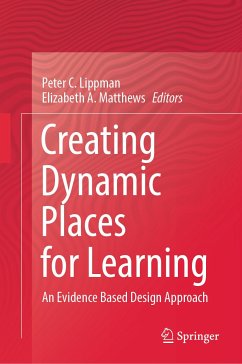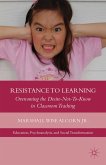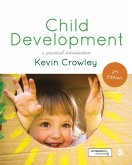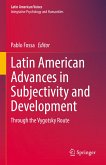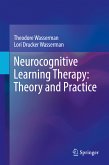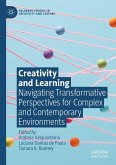Creating Dynamic Places for Learning (eBook, PDF)
An Evidence Based Design Approach
149,79 €
inkl. MwSt.
Sofort per Download lieferbar

0 °P sammeln
Creating Dynamic Places for Learning (eBook, PDF)
An Evidence Based Design Approach
- Format: PDF
- Merkliste
- Auf die Merkliste
- Bewerten Bewerten
- Teilen
- Produkt teilen
- Produkterinnerung
- Produkterinnerung

Bitte loggen Sie sich zunächst in Ihr Kundenkonto ein oder registrieren Sie sich bei
bücher.de, um das eBook-Abo tolino select nutzen zu können.
Hier können Sie sich einloggen
Hier können Sie sich einloggen
Sie sind bereits eingeloggt. Klicken Sie auf 2. tolino select Abo, um fortzufahren.

Bitte loggen Sie sich zunächst in Ihr Kundenkonto ein oder registrieren Sie sich bei bücher.de, um das eBook-Abo tolino select nutzen zu können.
This book showcases how an evidence-based design approach can be utilized in the planning of learning environments, by acknowledging the interconnectedness of research, practice, and theory as core considerations in the design of learning environments. Toward this end, this volume explores a multi-disciplinary perspective that draws upon modern learning theories, and empirical research from the fields of environmental psychology education, and architectural practice. By presenting this information in an accessible manner, it enables researchers, educators and designers to take actionable steps…mehr
- Geräte: PC
- ohne Kopierschutz
- eBook Hilfe
- Größe: 6.84MB
- Upload möglich
Andere Kunden interessierten sich auch für
![Resistance to Learning (eBook, PDF) Resistance to Learning (eBook, PDF)]() M. AlcornResistance to Learning (eBook, PDF)40,95 €
M. AlcornResistance to Learning (eBook, PDF)40,95 €![Child Development (eBook, PDF) Child Development (eBook, PDF)]() Kevin CrowleyChild Development (eBook, PDF)33,95 €
Kevin CrowleyChild Development (eBook, PDF)33,95 €![Routledge International Handbook of Music Psychology in Education and the Community (eBook, PDF) Routledge International Handbook of Music Psychology in Education and the Community (eBook, PDF)]() Routledge International Handbook of Music Psychology in Education and the Community (eBook, PDF)43,95 €
Routledge International Handbook of Music Psychology in Education and the Community (eBook, PDF)43,95 €![Latin American Advances in Subjectivity and Development (eBook, PDF) Latin American Advances in Subjectivity and Development (eBook, PDF)]() Latin American Advances in Subjectivity and Development (eBook, PDF)129,95 €
Latin American Advances in Subjectivity and Development (eBook, PDF)129,95 €![Neurocognitive Learning Therapy: Theory and Practice (eBook, PDF) Neurocognitive Learning Therapy: Theory and Practice (eBook, PDF)]() Theodore WassermanNeurocognitive Learning Therapy: Theory and Practice (eBook, PDF)65,95 €
Theodore WassermanNeurocognitive Learning Therapy: Theory and Practice (eBook, PDF)65,95 €![Creativity and Learning (eBook, PDF) Creativity and Learning (eBook, PDF)]() Creativity and Learning (eBook, PDF)113,95 €
Creativity and Learning (eBook, PDF)113,95 €![Public Places and Spaces (eBook, PDF) Public Places and Spaces (eBook, PDF)]() Public Places and Spaces (eBook, PDF)73,95 €
Public Places and Spaces (eBook, PDF)73,95 €-
-
-
This book showcases how an evidence-based design approach can be utilized in the planning of learning environments, by acknowledging the interconnectedness of research, practice, and theory as core considerations in the design of learning environments. Toward this end, this volume explores a multi-disciplinary perspective that draws upon modern learning theories, and empirical research from the fields of environmental psychology education, and architectural practice. By presenting this information in an accessible manner, it enables researchers, educators and designers to take actionable steps needed to re-imagine their settings and create dynamic places for learning.
Produktdetails
- Produktdetails
- Verlag: Springer Nature Singapore
- Erscheinungstermin: 22. August 2023
- Englisch
- ISBN-13: 9789811987496
- Artikelnr.: 68695077
- Verlag: Springer Nature Singapore
- Erscheinungstermin: 22. August 2023
- Englisch
- ISBN-13: 9789811987496
- Artikelnr.: 68695077
- Herstellerkennzeichnung Die Herstellerinformationen sind derzeit nicht verfügbar.
Peter C. Lippman, M. Phil, M. Psych., BArch, Associate AIA, has been researching, writing, and designing activity-based learning environments that engage teachers and learners. His work is grounded in his academic research and action research projects, where social science methodologies are used to guide the programming, planning, and design of learning environments. Fueled by his desire to understand how and why teachers and learners operationalize the different settings in the learning environment, he creates places that are responsive to their needs. He is an acknowledged Thought Leader in the field of educational architecture and a prolific writer. Peter not only presents his research at conferences internationally, but most importantly, works with educators throughout the world to re-imagine their environment to positively impact learning, learners and the things to be learned.
Elizabeth A. Matthews is Assistant Professor of Psychology and Education in the Division of Interdisciplinary Arts & Sciences at City College, CUNY. Her research interests center on the physical environment of children and youth, school security and violence, and the impacts of physical space on mental health in young people. She has conducted both quantitative and qualitative research on the physical elements of school security and hosted conferences that have brought an international group of researchers, policy-makers, and educators to dialogue on the key issues impacting school design.
Elizabeth A. Matthews is Assistant Professor of Psychology and Education in the Division of Interdisciplinary Arts & Sciences at City College, CUNY. Her research interests center on the physical environment of children and youth, school security and violence, and the impacts of physical space on mental health in young people. She has conducted both quantitative and qualitative research on the physical elements of school security and hosted conferences that have brought an international group of researchers, policy-makers, and educators to dialogue on the key issues impacting school design.
Introduction.- Part 1: Visioning process.- School designs for personalising and co-constructing the learning journey.- Working in non-western cultures: A framework for functional school design.- Pedagogy matters: Cultivating independent learning in college classrooms.- Part 2: Research in context.- The school security environment and adolescents’ feelings of safety and academic performance.- Making the transition from teacher-centred teaching to students’ active learning: developing transformative agency.- Out of the box: Lessons from the Covid-19 school lockdowns for future learning environments.- Virtual learning in university settings is not a new modality. Though old and new challenges continue to arise in recent years?- Part 3: Design.- Creating dynamic school buildings that activate the learner and the learning process.- Affordance theory as a framework for 21st century learning principles.- An ecological approach for creating dynamic learning environments.- Not buying into the hype of contemporary or new school learning spaces: One school’s attempt at interrogating their “actual” impact on teaching and learning.- Conclusion.
Introduction.- Part 1: Visioning process.- School designs for personalising and co-constructing the learning journey.- Working in non-western cultures: A framework for functional school design.- Pedagogy matters: Cultivating independent learning in college classrooms.- Part 2: Research in context.- The school security environment and adolescents' feelings of safety and academic performance.- Making the transition from teacher-centred teaching to students' active learning: developing transformative agency.- Out of the box: Lessons from the Covid-19 school lockdowns for future learning environments.- Virtual learning in university settings is not a new modality. Though old and new challenges continue to arise in recent years?- Part 3: Design.- Creating dynamic school buildings that activate the learner and the learning process.- Affordance theory as a framework for 21st century learning principles.- An ecological approach for creating dynamic learning environments.- Not buying into the hype of contemporary or new school learning spaces: One school's attempt at interrogating their "actual" impact on teaching and learning.- Conclusion.
Introduction.- Part 1: Visioning process.- School designs for personalising and co-constructing the learning journey.- Working in non-western cultures: A framework for functional school design.- Pedagogy matters: Cultivating independent learning in college classrooms.- Part 2: Research in context.- The school security environment and adolescents’ feelings of safety and academic performance.- Making the transition from teacher-centred teaching to students’ active learning: developing transformative agency.- Out of the box: Lessons from the Covid-19 school lockdowns for future learning environments.- Virtual learning in university settings is not a new modality. Though old and new challenges continue to arise in recent years?- Part 3: Design.- Creating dynamic school buildings that activate the learner and the learning process.- Affordance theory as a framework for 21st century learning principles.- An ecological approach for creating dynamic learning environments.- Not buying into the hype of contemporary or new school learning spaces: One school’s attempt at interrogating their “actual” impact on teaching and learning.- Conclusion.
Introduction.- Part 1: Visioning process.- School designs for personalising and co-constructing the learning journey.- Working in non-western cultures: A framework for functional school design.- Pedagogy matters: Cultivating independent learning in college classrooms.- Part 2: Research in context.- The school security environment and adolescents' feelings of safety and academic performance.- Making the transition from teacher-centred teaching to students' active learning: developing transformative agency.- Out of the box: Lessons from the Covid-19 school lockdowns for future learning environments.- Virtual learning in university settings is not a new modality. Though old and new challenges continue to arise in recent years?- Part 3: Design.- Creating dynamic school buildings that activate the learner and the learning process.- Affordance theory as a framework for 21st century learning principles.- An ecological approach for creating dynamic learning environments.- Not buying into the hype of contemporary or new school learning spaces: One school's attempt at interrogating their "actual" impact on teaching and learning.- Conclusion.
